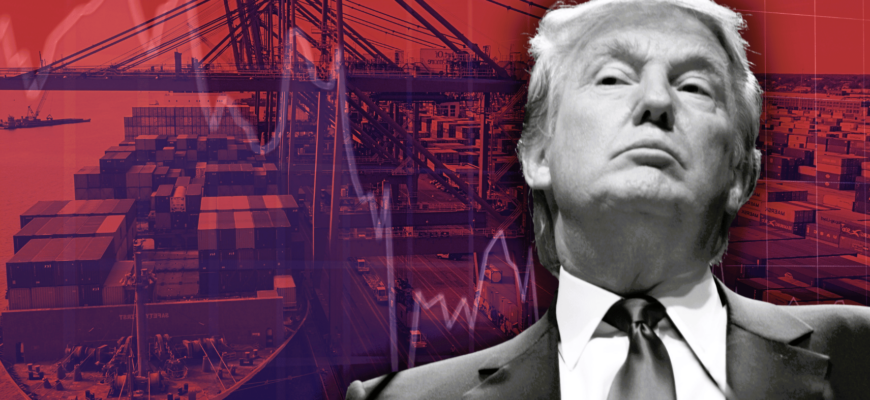When Donald Trump reclaimed the presidency in January 2025, he wasted no time reviving his focus on tariffs. On March 4, 2025, he unleashed a bold set of import taxes—25% on products from Canada and Mexico, plus a 10% hike on goods from China—igniting a firestorm of discussion about what this means for the U.S. economy. Journalists at TheMors have been digging into the details, exploring how these moves affect everything from small businesses to everyday shoppers and the broader global market. With U.S. trade valued at over $2.2 trillion yearly, the impact is already underway. Here’s a straightforward look at what’s happening, based on fresh insights as of March 5, 2025.
How Trump’s Tariffs Came to Be
The roots of this policy stretch back to Trump’s 2024 campaign, where he pitched tariffs as a fix for job losses and a tool to push back on issues like border security and drug flows. Using powers from the International Emergency Economic Powers Act, he signed orders on February 1, 2025, targeting three major trading partners: Canada, Mexico, and China. After a month-long buffer, the measures kicked in on March 4—25% on most Canadian and Mexican imports (with Canadian energy at 10%), and a jump from 10% to 20% on Chinese goods. Trump’s aim is clear: stop fentanyl trafficking, tighten immigration, and keep American interests front and center.
Immediate Effects: Prices and Supply Chains
The tariffs kicked in just a day ago, but their effects are already rippling. Businesses importing from Canada and Mexico now face a 25% tax on raw materials and finished products. Take the auto industry: parts cross North American borders multiple times before a car is built. A Chevy Silverado, for instance, might see costs jump by $3,000 per vehicle, according to TD Economics. Companies may pass this on to buyers, meaning higher car prices soon.
Consumers are feeling it too. Mexican fruits like avocados and limes, staples in U.S. kitchens, now cost more to import. Grocery chains are bracing for price hikes—some estimate a 10-15% increase on produce by April. Canadian lumber, vital for housing, faces the same 25% hit, pushing up construction costs in a market already short on homes. The National Association of Home Builders warns this could stall projects and raise home prices further.
China’s 20% tariff bump affects electronics and clothing. Apple, which assembles iPhones in China, might not raise prices immediately—analysts say they could shift production to India or absorb costs—but smaller firms may not have that flexibility. Supply chains are scrambling to adjust, with some U.S. importers already hunting for alternatives.
Jobs: Winners and Losers
Trump says tariffs will create jobs by protecting American industries. Steel and aluminum makers, for example, could see a boost as imports get pricier. During his first term, similar tariffs added about 1,000 steel jobs, per the U.S. Bureau of Labor Statistics. But the bigger picture is murkier. A 2024 study by MIT’s David Autor found those tariffs didn’t broadly lift employment in protected sectors—and retaliation from other countries hurt more jobs than they saved.
This time, retaliation is underway. Canada slapped $30 billion in tariffs on U.S. goods like oil and potatoes on March 4, with more planned. Mexico’s President Claudia Sheinbaum is prepping reciprocal taxes, targeting U.S. agriculture—think pork and soybeans. China’s hitting back with 15% duties on U.S. coal and farm products. These moves threaten American exporters, especially farmers in the Midwest, who lost $6 billion to China’s retaliation in 2018-2019.
Manufacturing could take a hit too. Companies relying on Canadian or Mexican parts—like automakers in Detroit—face higher costs, potentially cutting production or jobs. The Tax Foundation estimates Trump’s tariffs could shrink U.S. employment by 142,000 jobs long-term if retaliation escalates.
Inflation and Consumer Costs
Prices are the big worry. The Federal Reserve of Atlanta predicts these tariffs could push everyday costs up by 0.8-1.6% within months. Gas prices might rise 10-20 cents a gallon, as 100% of Midwest oil imports come from Canada, per the Cato Institute. Electronics, furniture, and food—all tied to these countries—will cost more too. The Budget Lab at Yale pegs the average household loss at $1,000 in purchasing power annually.
Inflation, already a headache after 2024’s ups and downs, could climb again. Economists like Joseph Stiglitz warn this might force the Federal Reserve to tighten policy, slowing growth. Trump counters that tariff revenue—projected at $100 billion yearly by the Tax Foundation—could offset this with tax breaks. But if imports drop 15%, as Bloomberg Economics forecasts, that revenue might fall short.
Global Trade Shake-Up
The tariffs strain ties with key partners. The U.S.-Mexico-Canada Agreement (USMCA), signed under Trump in 2020, aimed for free trade. Now, Canada and Mexico argue these taxes violate it, with Canada filing a World Trade Organization complaint on March 4. If unresolved, this could spark a broader trade war, disrupting $1.3 trillion in North American commerce.
China’s response adds another layer. Its export controls on minerals and tech probes into U.S. firms like Google signal a tit-for-tat escalation. Yet China’s economy, less reliant on U.S. trade than in 2016, might weather this better—its yuan’s 2025 dip already cushions the blow.
Europe’s watching closely. Leaders in France and the UK, backing Ukraine against Russia, might fill the U.S. aid gap if Trump pulls back, shifting global alliances. For American businesses, the uncertainty is a headache—supply chains built on decades of open trade now face upheaval.
Winners, Losers, and What’s Next
Who Benefits?
- Domestic Producers: Steel, energy, and niche manufacturers could gain if imports slow.
- Treasury: Short-term revenue from tariffs might fund Trump’s tax plans.
- Trump’s Base: Supporters see this as delivering on “America first” promises.
Who’s Hurt?
- Consumers: Higher prices hit wallets, especially for low-income households.
- Exporters: Farmers and manufacturers face foreign retaliation.
- Small Businesses: Those reliant on imports lack the scale to pivot quickly.
The future hinges on how long these tariffs last. Trump calls them a negotiating tool—Canada and Mexico might bend on border security to dodge them. But if they dig in, or if China escalates, the U.S. economy could see slower growth (down 0.2% GDP, per Yale’s Budget Lab) and persistent inflation. Talks could resume, exemptions might emerge, or Congress could push back—Trump needs their buy-in for bigger budget plays.
Conclusion: A Risky Bet
Trump’s tariff rollout on March 4, 2025, is a high-stakes play to reshape the economy. It’s giving some sectors a lift but piling pressure on shoppers and exporters. The strategy might work if it forces deals and revives U.S. production—or falter if costs and counter-moves drag growth down. One day in, the jury’s out, but the impact is real.
TheMors journalists are on this story as it unfolds. For more on Trump’s tariff policy and its economic impact, visit TheMors – Breaking News. Check out our latest takes, stay updated, and join the conversation!









